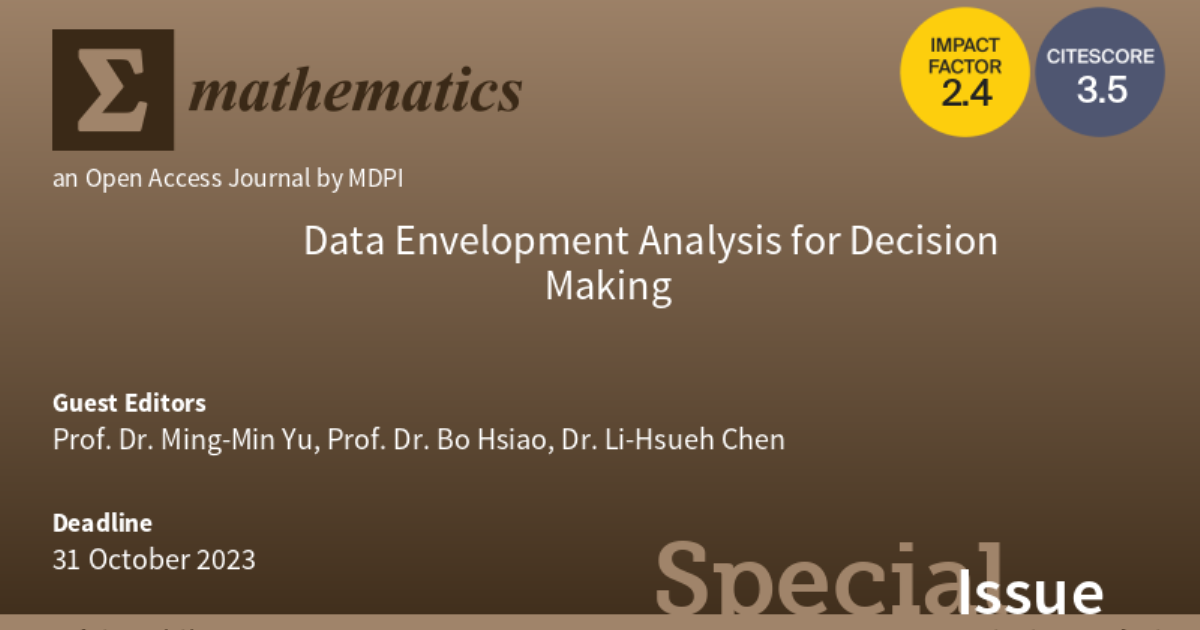Data Envelopment Analysis for Decision Making
A special issue of Mathematics (ISSN 2227-7390). This special issue belongs to the section "Computational and Applied Mathematics".
Deadline for manuscript submissions: closed (31 October 2023) | Viewed by 2052

Special Issue Editors
Interests: economics; operational research; transportation; logistics performance evaluation; data envelopment analysis
Interests: performance evaluation; data analysis; operational research; machine learning
Special Issue Information
Dear colleagues,
Data Envelopment Analysis (DEA), initially developed by Charnes et al. (1978), is an optimization method of mathematical programming to generalize the Farrell (1957) single-input/single-output technical efficiency measure to the multiple-input/ multiple-output case by constructing a relative efficiency score as the ratio of a single virtual output to a single virtual input. Thus, DEA has become a new tool in operational research for measuring the technical efficiency of decision-making units.
Recently, DEA has been extended in both theoretical development and applications. We look forward to original analytical and empirical research using the DEA approaches with practical applications in various areas. Applications (including but not limited to) in finance, banking, healthcare, transportation, education, energy, environment, and more will be considered. New and improved models of DEA are encouraged. A Special Issue that compiles current research on the state of the art will benefit the DEA community.
Prof. Dr. Ming-Min Yu
Prof. Dr. Bo Hsiao
Dr. Li-Hsueh Chen
Guest Editors
Manuscript Submission Information
Manuscripts should be submitted online at www.mdpi.com by registering and logging in to this website. Once you are registered, click here to go to the submission form. Manuscripts can be submitted until the deadline. All submissions that pass pre-check are peer-reviewed. Accepted papers will be published continuously in the journal (as soon as accepted) and will be listed together on the special issue website. Research articles, review articles as well as short communications are invited. For planned papers, a title and short abstract (about 100 words) can be sent to the Editorial Office for announcement on this website.
Submitted manuscripts should not have been published previously, nor be under consideration for publication elsewhere (except conference proceedings papers). All manuscripts are thoroughly refereed through a single-blind peer-review process. A guide for authors and other relevant information for submission of manuscripts is available on the Instructions for Authors page. Mathematics is an international peer-reviewed open access semimonthly journal published by MDPI.
Please visit the Instructions for Authors page before submitting a manuscript. The Article Processing Charge (APC) for publication in this open access journal is 2600 CHF (Swiss Francs). Submitted papers should be well formatted and use good English. Authors may use MDPI's English editing service prior to publication or during author revisions.
Keywords
- performance evaluation
- technology gaps
- benchmarking
- allocation
- reallocation
- mobility
- efficiency
- decision making
- productivity
- data reduction
- productivity
- optimization
- efficiency measurement
- data analysis
- bootstrapping
- regression analysis
- competition
- multiple activities
- network
- dynamics
- malmquist index
- returns to scale
- problem solving
- data envelopment
- mathematical programming
- numerical model
- sensitivity analysis
- total factor productivity





